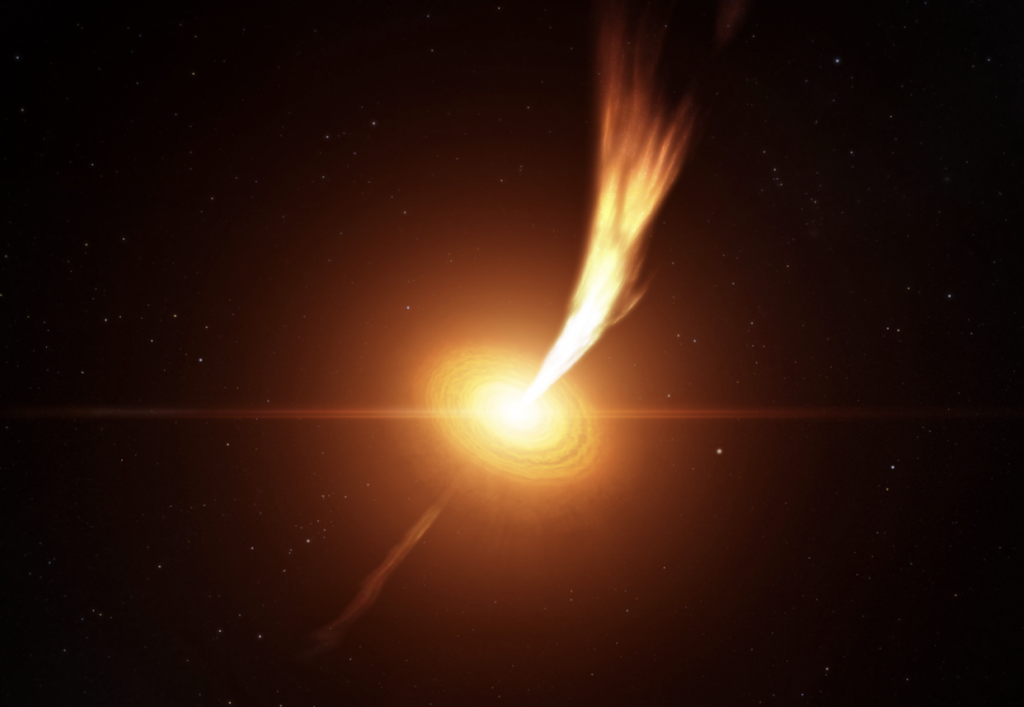The U.S. National Science Foundation National Radio Astronomy Observatory (NSF NRAO), in partnership with several leading Mexican universities and research institutes, has announced a series of landmark agreements and meetings aimed at advancing Mexico’s role in the Next Generation Very Large Array (ngVLA) project.
Recent News
Astronomers Discover a Superheated Star Factory in the Early Universe
Astronomers have uncovered a previously unknown, extreme kind of star factory by taking the temperature of a distant galaxy using the ALMA telescope. The galaxy is glowing intensely in superheated cosmic dust while forming stars 180 times faster than our own Milky Way.
Astronomers Share Largest Molecular Survey To-date: GOTHAM Legacy Data Goes Public
Astronomers in the “GBT Observations of TMC-1: Hunting Aromatic Molecules” research survey, known as GOTHAM, have released a spectral line survey with largest amount of telescope time ever conducted, charting more than 100 molecular species only found in deep space.
NSF NRAO Achieves First Successful Observations with New NSF VLBA Digital Architecture

The U.S. National Science Foundation National Radio Astronomy Observatory (NSF NRAO) has successfully completed initial observations using its newly upgraded NSF Very Long Baseline Array (NSF VLBA) digital systems, marking a significant milestone in radio astronomy instrumentation. The new NSF VLBA New Digital Architecture (VNDA) produced its first fringes and subsequent images in January 2025, demonstrating the successful implementation of next-generation technology that will enhance the NSF VLBA’s scientific capabilities for years to come.
The NSF VLBA, comprising ten radio antennas spanning from Hawaii to the U.S. Virgin Islands, has received a critical upgrade to replace its aging Roach Digital Back Ends (RDBEs). These digital backends are essential components that convert analog signals from each antenna into digital data for correlation and processing. The obsolete systems faced severe parts shortages, prompting the development of the new VNDA system.
“This upgrade represents a crucial obsolescence mitigation effort that ensures the VLBA will continue to serve both scientific and national interests with enhanced capabilities,” said Walter Brisken of the NSF NRAO, the VLBA Development lead.
The new system has been successfully installed at the Owens Valley and Pie Town NSF VLBA stations, with monitor and control systems functioning as expected. The upgrade includes three primary components:
- New digital radiometer systems (samplers)
- 100 Gbps network switch
- Advanced channelizer system for signal processing
First Light Achievements
The images and data provided in the announcement show the first successful fringes obtained between the Los Alamos station and both Owens Valley and Pie Town stations on January 30, 2025. Fringes—the interference patterns produced when signals from different antennas are combined—confirm that the system is working properly and that precise timing synchronization has been achieved.
Following these initial tests, the team produced high-quality radio images of what appears to be the quasar 3C345, a powerful active galactic nucleus approximately 7.8 billion light-years from Earth. The image clearly shows the bright central core and extended structure of this cosmic radio source.
The VNDA upgrade provides several significant improvements over the previous system:
- Higher sampling rates with more than 8 bits per sample for greater sensitivity
- Improved delay stability through elimination of sampler resets
- Flexible tuning capabilities within frequency bands
- Backward compatibility with existing systems
- Support for user-provided guest equipment such as spectrometers, pulsar backends, and transient detectors
“The VLBA’s incredible resolution—equivalent to standing in New York and reading a newspaper in Los Angeles—depends on precise digital processing of signals from widely separated antennas,” explained Lucas Hunt from the NSF NRAO. “This upgrade ensures we maintain and enhance this capability for the next generation of radio astronomers.”
The successful implementation at two NSF VLBA stations paves the way for upgrading all ten stations in the array. The VNDA project represents a significant investment in the future of very long baseline interferometry in the United States, ensuring this world-class instrument remains at the forefront of radio astronomy research.
The NSF VLBA will continue its scientific mission of studying everything from nearby stars to distant galaxies with unprecedented detail, contributing to our understanding of cosmic phenomena including black holes, stellar evolution, galaxy formation, and the expansion of the universe.
About NRAO
The National Radio Astronomy Observatory is a facility of the U.S. National Science Foundation, operated under cooperative agreement by Associated Universities, Inc.
This news article was originally published on the NRAO website on May 13, 2025.
Recent News
NSF National Radio Astronomy Observatory and Mexican Institutions Sign Historic Agreements to Advance ngVLA Collaboration
The U.S. National Science Foundation National Radio Astronomy Observatory (NSF NRAO), in partnership with several leading Mexican universities and research institutes, has announced a series of landmark agreements and meetings aimed at advancing Mexico’s role in the Next Generation Very Large Array (ngVLA) project.
Astronomers Discover a Superheated Star Factory in the Early Universe
Astronomers have uncovered a previously unknown, extreme kind of star factory by taking the temperature of a distant galaxy using the ALMA telescope. The galaxy is glowing intensely in superheated cosmic dust while forming stars 180 times faster than our own Milky Way.
Astronomers Share Largest Molecular Survey To-date: GOTHAM Legacy Data Goes Public
Astronomers in the “GBT Observations of TMC-1: Hunting Aromatic Molecules” research survey, known as GOTHAM, have released a spectral line survey with largest amount of telescope time ever conducted, charting more than 100 molecular species only found in deep space.
